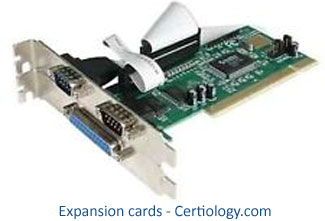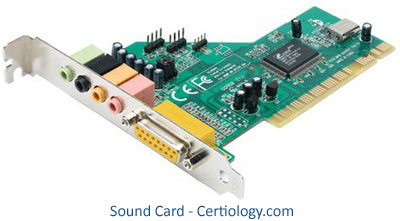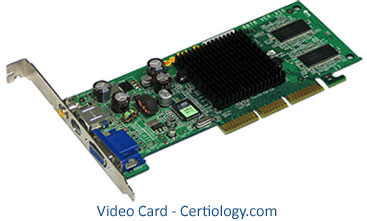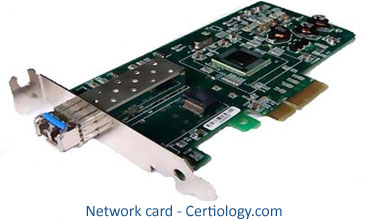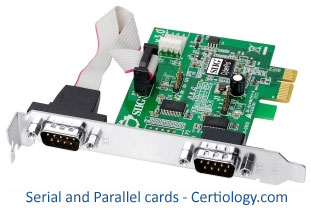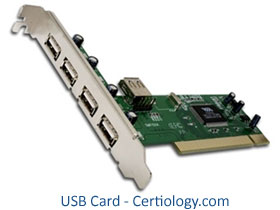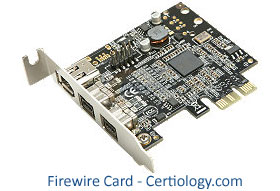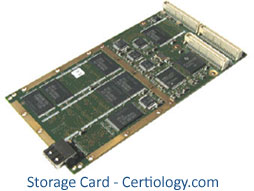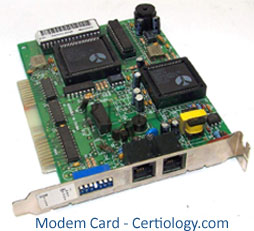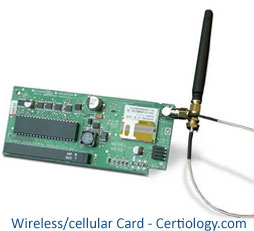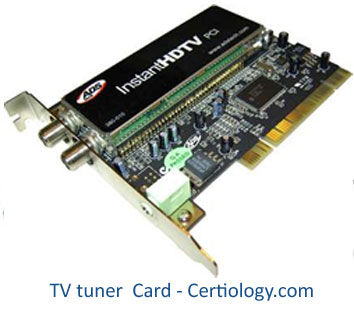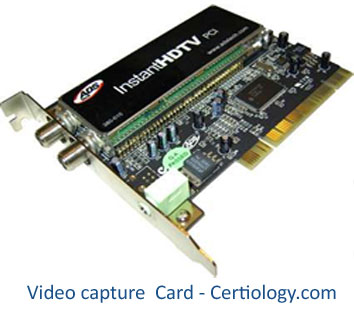Expansion Cards
Expansion Cards
In computing, an expansion card is defined as a specific type of circuit board that is inserted into a computer to provide extra features, facilities or memory. This can include a wide variety of things, which will be detailed in this article.
Expansion cards are inserted into an expansion slot on the computer’s motherboard and create an electronic link between the two with edge connectors so data can be communicated across. They became popular soon after they were first introduced and remain popular to this day due to the opportunities they offer users to fully customise their computing experience.
Sound card
Also known as an audio card, this type of expansion card deals with everything to do with sounds and audio signals within the computer that are under the control of programs on the computer. This can include allowing applications on the computer to play music, programs which edit videos or audio, presentation software, games equipment and any other type of program which plays audio.
The ability to play sound is often integrated into the motherboard of the computer, however this is not necessarily the best way to achieve high-quality sound. Sound expansion cards convert digital sound data into analog format, which is then relayed to an external device capable of playing sound such as headphones or a speaker. Sound cards also need to be capable of processing multiple sounds at the same time, splitting them up into audio channels. This allows different sound configurations to be produced, such as surround sound and stereo sound. Modern sound cards providing advanced sound mixing such as this are sometimes referred to as Hardware Audio Accelerators and can provide features such as positional audio and 3D sound.
Video card
A video card is more often called a graphics card or display card, and is responsible for generating images to a visual display such as a computer monitor or laptop screen. Although all motherboards have some degree of integrated graphics, a dedicated video card allows for higher quality graphics and better speeds. Video cards can offer such functions as the rendering of high-quality 3D and 2D graphics, the ability to connect to a TV and the ability to display graphics across multiple display screens.
A dedicated video card comes with its own RAM and cooling system, decreasing the reliance on the motherboard and allowing more processing power to be sectioned off solely for the display and processing of graphics. This can also help the computer as a whole to run faster and more efficiently as less system RAM power is being taken up by high demand graphics programs.
Network card
Often called a Network Interface Card or LAN Adapter, a network card is an expansion card which allows a computer to connect to a computer network such as a Local Area Network or Wide Area Network. This type of expansion card was most popular in early models of computers, in more modern machines almost all computers have a network interface built directly into the motherboard.
This is because it is cheaper and more convenient to use the Ethernet standard connection, which is easy to install as a chip straight from the motherboard and does not necessarily require a separate expansion card any more. For this reason, separate network cards are all but obsolete in newer computers other than in exceptional circumstances where a different type of network connection is required.
Serial and Parallel cards
Serial and Parallel expansion cards are used to provide additional connection ports to a computer, specifically to provide either parallel or serial port connections. A parallel port is only able to transmit data one way to a secondary device, commonly a printer or similar, using a dual data transmission system.
This type of one-way transmission was also used for older external storage devices. Serial ports are able to process data in a two-way direction, and are often slightly slower than parallel ports due to the more accurate transmission of data they send. Both serial ports and parallel ports have been mostly superseded by the faster and more efficient USB port in modern computers.
USB card
A USB expansion card is used to provide additional connection ports to a computer by connecting the card to the motherboard. USB is short for Universal Serial Bus, and is the most common type of port found in modern computers. Peripherals such as printers, keyboards, printers, removable flash drives and mice can be attached to the computer.
USB cards are necessary if a computer does not already have this capability, or to add additional ports for more use of external devices at once. USB connections are faster at transmitting data and quickly became a general industry standard for cross-platform communication.
Firewire card
A firewire card is used to provide computers with an IEEE 1394 interface connection, also known as a firewire. The term was coined by Apple in the early 1990s, and the ports themselves have been included on most apple computers since the year 2000. Recently Apple has begun replacing this port with the Thunderbolt interface on all modern Mac computers. The port itself is very similar to a USB connection, although USB is much more popular across a range of cross-platform devices and the two are not interchangeable.
Storage card
A storage card, often also called a flash memory card or simply a memory card that is connected to a computer in order to provide users with extra space to store their data on. This can include data such as music, pictures, text or video and is transferable to other devices such as digital cameras and mobile phones. These cards vary in both physical size and data capacity, and are constantly being developed and upgraded. Some of the most common on the market today include the Secure Digital (SD) Card, the Mini/Micro SD Card, and the MultiMediaCard (MMC).
Data secured on storage cards is very stable and not in much danger of being lost or damaged outside of any actual physical damage to the card itself. Cards are much smaller physically than they were even as recently as 10 years ago, and some such as the Compact Flash card have been made almost obsolete by the introduction of more stable non-volatile memory devices. Storage cards also have an advantage over hard disk drives as they are very portable, allow immediate access when booted up and do not require cooling. There is a huge market among users for small, light-weight and low power storage devices with increasingly large amounts of data storage capacities.
Modem card
A modem card allows a computer to send an analog carrier signal carrying digital information, and decodes the reverse of this signal in return to reproduce the original digital data. The most common way of doing this in the past was by using electrical signals transmitted over telephone lines, although more modern systems such as satellite, WiFi, mobile phones and mobile broadband modems also use this type of communication. Wireless modems can be embedded inside of a device or be external to it, and can be locked to only receive certain types of frequency signals, for example only those from one particular network provider.
Modern broadband modems are not limited to using telephone line, with newer types using satellite, television cables and power lines to transmit data signals. These are much more advanced than the older ‘dial-up’ style of modem, with much faster transmission of data and a hugely expanded range of channels available for use simultaneously. Modems are usually classified by how much data they are able to transfer in a set amount of time, generally bits per second (bps) or bytes per second (B/s), and this data can be used to compare modems when buying or choosing between them.
Wireless/cellular card
A wireless card is used to provide a computer with the capability of connecting to a radio-based computer network rather that one which is connected using wires. These can come preinstalled inside of a computer or laptop or be external, come separately, although almost all modern devices come with this already included inside of the computer. The most common use of this card is to allow a device to connect to WiFi, using a wireless router or access point. The WiFi point receives data through wires and transmits it using radio waves, for a wireless card inside of a device to pick up and decode, as well as receiving the signals in the opposite direction.
The signals transmitted are on a different frequency to other radio wave transmissions, such as those used by radios and mobile phones, and are able to handle much more data than these other types. Wireless cards can also move around onto different frequency channels if one becomes too full with users, helping to make sure the transmission of data is always fast and efficient. Wireless cards can come in several different types, including PCI, mini PCI and PCIe, different ones of which are more suitable for different devices. Some USB devices also exist which are capable of acting as a wireless card and allowing a device to connect to WiFi or Bluetooth networks.
TV tuner card
A Television Tuner card is a card which is inserted into a computer to allow a device to receive television signals that would not otherwise be suited to picking them up. Cards are usually either PCI, mini PCI or PCIe, or sometimes as an external USB device. Most cards have an inbuilt processor to free up space from the system’s CPU and ease the pressure on the computer. Cards can be either analog or digital depending on which type of television the user wishes to view, and many hybrid tuners exist which are able to switch between the two types. High-end tuner cards often include a special chip to encode and decode the data being transmitted, however smaller and cheaper cards are less likely to have this capability due to the high power it takes to run them.
Many TV tuner cards also include a form of flash memory which allows them to store several different types of decoding software, meaning the tuner card can be used in many different countries and with different video formats without reformatting the system to recognize the new data.
Video capture card
A video capture card is used to allow a computer to convert an analog video signal into a digital video data form. Many TV tuner cards double up as video capture cards, allowing the user to record TV transmissions as they are being broadcast and viewed.
The inclusion of a dedicated video card is important in a system as the circuitry required to convert analog video to digital video is quite specialised and high-performance. Data must be digitised and modified to account for colour differences and encoded to a completely different format, as well as separating the different aspects of composite video if this is captured.
Read more
- Configure and apply BIOS settings
- Differentiate between motherboard components, their purposes, and properties
- Compare and contrast RAM types and features
- Install and configure expansion cards
- RAM
- Motherboard Components
- Computer Ports and Connections
- Optical Disk Storage Options
- Motherboard Processors and Memory
- Peripherals and Expansion
- Display Devices
- Custom Configurations
Practice Test
Computer Hardware Technician Interview Questions

